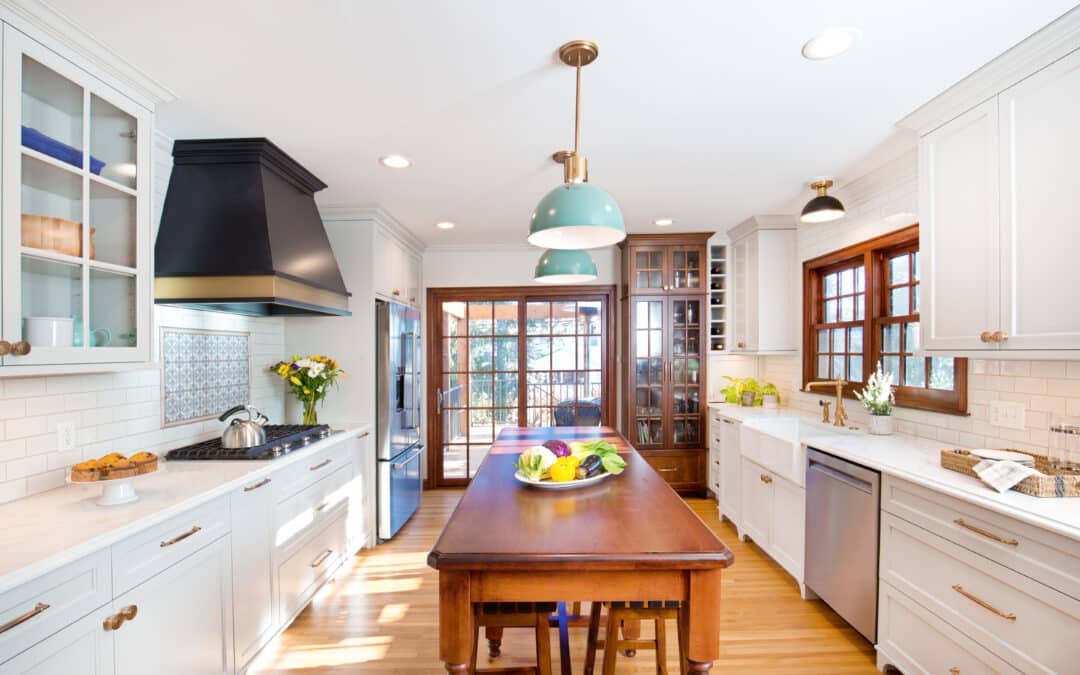The right tile style and color transform any space, seamlessly blending interior design with the architectural essence of your home.
 With the growing variety of tile options available, choosing the right one for your next project can feel overwhelming.
With the growing variety of tile options available, choosing the right one for your next project can feel overwhelming.
Key decisions like selecting the material and size must come before considering color or finish. Since tiles are often used in high-traffic areas, it’s important to evaluate maintenance requirements and suitability for stain-prone spaces like kitchens and bathrooms. Additionally, measuring the area ensures you select the proper shape, pattern, and color. Considering these factors in advance will streamline your tile selection process and make designing your space much simpler.
History of Tile
Understanding the history of tile helps us to better understand it and its intended use. Tile is believed to have originated around 1000 B.C. in China and Egypt. It was designed to be decorative and to have a practical purpose.
During this period, tile was made from sand, clay, and even rocks, but the tiles were not glazed. When glazing (enamel coating) came along in the ninth century, it was a game changer, increasing tile’s popularity and demand because glazing made tile “water impermeable.”
By the 18th century, machines that pressed dry clay together made tile more accessible and even more popular. In 1870, the U. S. started producing its own tiles. By the early 1900s, tile was becoming so popular that during the building of the New York Subway, tile was used as a design element, giving birth to the ever-popular “subway tile.”
 Material
Material
Tiles come in various styles and materials, each offering unique aesthetic and functional qualities to suit different design needs.
Glass. Glass tiles are ideal for bathrooms and kitchens. They offer a clean and sleek design that works especially well in modern spaces. Their reflective surface enhances the contemporary feel, making them a staple in creating a polished, minimalist look.
Mosaic. Made from small pieces of glass, metal, stone, porcelain, marble, or travertine, mosaic tiles add intricate detail and visual interest. They are an excellent choice for vintage-inspired designs, such as modern farmhouse interiors.
Travertine. A hallmark of Tuscan-style design, travertine is a limestone tile. With its rustic charm and natural shades of rust, brown, and tan, they bring warmth to any space.
Ceramic. Crafted from a combination of clay, minerals, and water, ceramic tiles are fired in a kiln for durability. They are available in a multitude of shapes and sizes, making them one of the most versatile options on the market.
Cement. Created from a combination of water, sand, and cement, these tiles are similar to ceramic tiles in function but offer a more robust look. This tile works great in modern, industrial, and even rustic designs.
Marble. This tile is a natural stone that features unique natural veining. It is ideal for bathroom and kitchen backsplashes. With its sophisticated and classy look, this tile will help tie any traditional design together.
Space Requirements
When selecting tiles for a specific room, it’s essential to consider the space’s unique requirements. Kitchens, bathrooms, laundry rooms, and even mudrooms often experience high moisture and require water-resistant, easy-to-clean tiles. Porcelain tiles are an excellent choice because they are less porous, making them highly resistant to water and stains. Ceramic tiles are also water and heat-resistant but are more prone to moisture-related damage over time compared to porcelain.
Natural stone tiles, while durable and scratch-resistant, are the most porous and require regular sealing to prevent staining and discoloration. Though they demand more maintenance, including frequent cleaning and sealing, their longevity and timeless appeal make them a popular choice for spaces where durability is key.

Style and Color
Choosing the perfect style and color of tile plays a crucial role in defining a home’s architectural design. Whether your project is a new build or renovation, tile work is where the home starts to come to life.
Thoughtful tile selection bridges the interior design with the exterior architecture, creating a cohesive look from the outside in. To achieve cohesiveness, understanding the history and background of the home’s design is essential. For example, travertine is the top tile choice for a Tuscany-style home because it mimics the limestone and sandstone found in Tuscan quarries. Pairing natural stone with matte tiles instead of glossy finishes adds an authentic Tuscan flair to the design.
Tile color also depends on the style of the home and regional influences. For example, earth tones such as rusts, browns, and creams are common in Tuscan homes because of the natural materials available in that region of the world.
When selecting tile for specific spaces, consider how color impacts the room’s feel. Darker tiles such as charcoal or walnut are more suitable for larger spaces because these darker colors absorb light, creating a cozier and more intimate atmosphere. In contrast, lighter colors like white and beige are perfect for smaller rooms because they reflect light and create an airy, more expansive feel.
 Sizing up the space to be tiled is also an important part of the step toward creating an aesthetically pleasing home. Not every shape, size, or pattern is made to work in every room.
Sizing up the space to be tiled is also an important part of the step toward creating an aesthetically pleasing home. Not every shape, size, or pattern is made to work in every room.
Again, knowing the background and origin of the home helps with your selection of patterns. Choosing a tile that is relevant to the size of the room is always a good starting point. A large room such as a kitchen or living room can handle larger-sized tiles, but medium-sized rooms like bathrooms need medium tiles. Mosaic tiles, which are very popular in modern farmhouses, work great in small spaces.
Tiles come in a variety of shapes these days, adding varying levels of visual interest to a home and defining the personality and character of the rooms in which it is used. Selecting the right one can be very confusing. Square tiles and hexagon tiles are a big look for 2024. Both work well in traditional and modern homes. The shape of your tile will impact the overall feeling of a room, influencing the perception of the room’s size and mood.
Selecting the right tile for your next investment property can be achieved easily by understanding the architectural design of the home, its history, and the practical needs of each room to be tiled. Considering factors like how a room will be used, its shape and size, and which patterns, and colors would work will before hitting the stores will give you some direction and make you feel more in control. With hundreds of tiles to choose from, selecting the right tile for the right room will feel less stressful if you do your homework before you arrive at the tile stores. Buying tile with confidence will aid you in your design process and help you to create beauty and value for any project.
























Just finished installing grey cabinets in our fix and flip. My wife picked gold knobs and fixtures but we are having a hard time with the back splash. The post is really insightful, now because of you guys have my wife and I have to take another trip Flooring and Decor. 😂 Great post! Thank you.